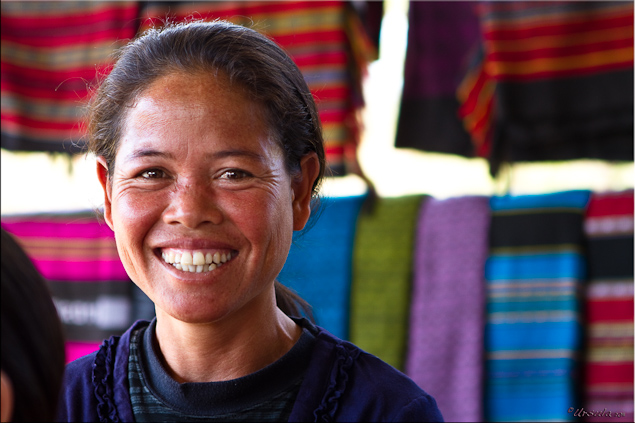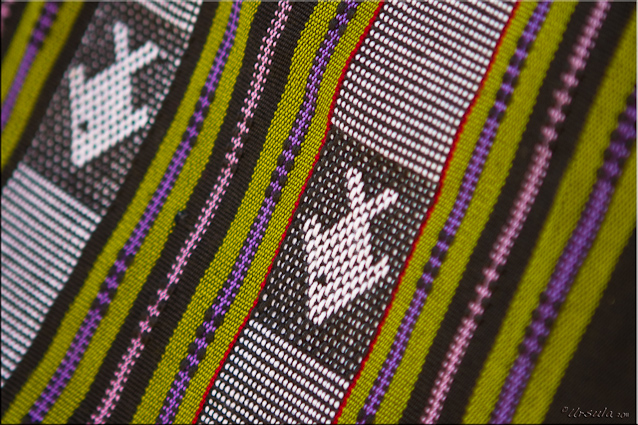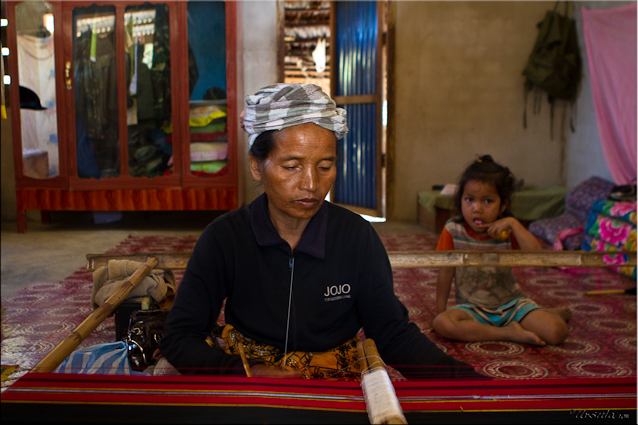
Taliang Woman and Taliang Weaving
If you have very little to start with, it takes very little to make a big difference.
Attapeu province in the southernmost part of Laos provides access to the infamous Ho Chi Minh Trail and two National Diversity Conservation Areas – and very little else. During the French administration it was a base for Nation Liberation and, as a consequence, was totally destroyed during the war against imperialism. It is still relatively undeveloped and is home to at least 14 ethnic groups living in traditional communities. As of 2003, the average income was less than $200 per head per annum.
Laos as a whole is still predominantly rural, with a high birth rate (3.22 children per woman; ranked 56th out of 223 countries, as reported in the CIA World Factbook, 2010) and a high infant mortality rate (61.19 deaths/1,000 live births; 35th in the world). In remoter areas like Attapeu, these figures are likely to be higher, and the burden of care falls upon the women. I mentioned last week how Khun Napat Sirisambhand, an enthusiastic Thai working with a small World Bank grant, was helping the Attapeu Lao Women’s Union support local cottage industries – in particular, basketry, pottery and weaving.
So it was that in January of this year (2011), Khun Napat took a number of members of the Thai Textile Society to visit the Taliang people of Ban Sivalai, to see how these village weavers have succeeded, in a small way at least, in turning their traditional cotton ‘belt-loom’ or ‘back-strap’ weaving into a cottage industry that produces something marketable in the twenty-first century, generating income for their community.

Taliang Cotton Fish

Everyone Works: Granny Reeling while Orphaned Grandchild Sits Behind

Belt-Loom Weavers on the Porch

What are They Looking at?

Support Worker from the Attapeu Lao Women's Union

Back Strap or Belt Loom Weaving

Close Work
Pieces produced by Back-Strap or Belt-Loom weaving are limited by the width of the strap and the length of the weaver’s legs. For traditional clothing, finished pieces were often sewn together. Khun Napat found Lao cottons to be of inferior grade for commercial purposes and so takes Thai cotton and Thai cotton-silk blends into Attapeu for the women to turn into colourful table-runners and place-settings for international sale.

Traditional Patterns in New Textiles with Natural Dyes

Inside the Community House
I watched a woman finish an olive green runner with white frogs patterned into it and couldn’t resist! She charged me 50,000 Kip – roughly US$6.20 – for something that had taken her a couple of days to make, and we both went away happy.

Olive Green and Mine!

My Weaver ~ a 32 year old mother of two with a third child arriving shortly. I have no idea why she was wearing a shower cap!

Communal Kitchen ~ Ban Sivilai, Taliang Village, Laos

Still-Life Found : Ban Sivilai, Laos

New Wooden Home, Under Construction, Ban Sivilai, Laos

Unusual toys: A Tin Can, a Lump of Dung and a Rock

Bits of Bread and a Bike

Taliang Baby with Bread
I watched the children playing in the dirt, as one hammered an aluminium can into submission and another pounded a plastic bag of cow dung with a rock. I watched the determination with which all the children greeted the bits of bread rolls we had left over from our breakfast. Solemn and unsmiling.
Certainly, some of the women we met here have energy, intelligence and enthusiasm. These are the ones who go outside the community to attend workshops to learn how to develop their methods and improve their products. These are the ones who keep these marginalised communities moving forward. Over time, small projects like  this one have make a big difference. I shake my head at what conditions must have been like some twelve years ago.
this one have make a big difference. I shake my head at what conditions must have been like some twelve years ago.
And I wonder at the work left to do…



.jpg)



















.png)


Amazing the simplicity in which they live, we have children here that more is not enough and yet these children sit and play contently with very, very little… amazing people, wonderful pictures and i agree what must it have been like before it this is how it is now…
What an fabulous experience…
love to you both… Signe
Hey Signe! True, isn’t – we could all learn a thing or two about downsizing our ‘needs’. 🙂
Interesting series of photos Ursula.
Thanks for visiting Kevin! It was a bit hard to get an angle on the place… or in the place…
[…] reminded me how much I love Laos: the songs, dances and smiles of the people, the brilliant hand-woven fabrics, the colourful markets, the ethnic villages, the beautiful countryside… I’m less fond […]